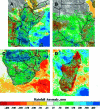Prediction, assessment of the Rift Valley fever activity in East and Southern Africa 2006-2008 and possible vector control strategies
- PMID: 20682905
- PMCID: PMC2913499
- DOI: 10.4269/ajtmh.2010.09-0289
Prediction, assessment of the Rift Valley fever activity in East and Southern Africa 2006-2008 and possible vector control strategies
Abstract
Historical outbreaks of Rift Valley fever (RVF) since the early 1950s have been associated with cyclical patterns of the El Niño/Southern Oscillation (ENSO) phenomenon, which results in elevated and widespread rainfall over the RVF endemic areas of Africa. Using satellite measurements of global and regional elevated sea surface temperatures, elevated rainfall, and satellite derived-normalized difference vegetation index data, we predicted with lead times of 2-4 months areas where outbreaks of RVF in humans and animals were expected and occurred in the Horn of Africa, Sudan, and Southern Africa at different time periods from September 2006 to March 2008. Predictions were confirmed by entomological field investigations of virus activity and by reported cases of RVF in human and livestock populations. This represents the first series of prospective predictions of RVF outbreaks and provides a baseline for improved early warning, control, response planning, and mitigation into the future.
Figures




References
-
- Megan JM, Bailey CL. In: The Arboviruses: Epidemiology and Ecology. Monath TP, editor. Volume IV. Boca Raton, FL: CRC Press Inc; 1989. pp. 51–76. (Rift Valley fever).
-
- Little PD. Hidden Value on the Hoof: Cross-Border Livestock Trade in Eastern Africa. 2009. http://www.nepad-caadp.net/pdf/COMESA%20CAADP%20Policy%20Brief%202%20Cro... Common Market for Eastern and Southern Africa Comprehensive African Agriculture Development Program, Policy Brief Number 2, February 2009. Available at. Accessed August 5, 2009.
-
- Linthicum KJ, Anyamba A, Tucker CJ, Kelley PW, Myers MF, Peters CJ. Climate and satellite indicators to forecast Rift Valley fever epidemics in Kenya. Science. 1999;285:397–400. - PubMed
-
- Logan TM, Linthicum KJ, Ksiazek TG. Isolation of Rift Valley fever virus from mosquitoes collected during an outbreak in domestic animals in Kenya. J Med Entomol. 1992;28:293–295. - PubMed
Publication types
MeSH terms
Grants and funding
LinkOut - more resources
Full Text Sources

